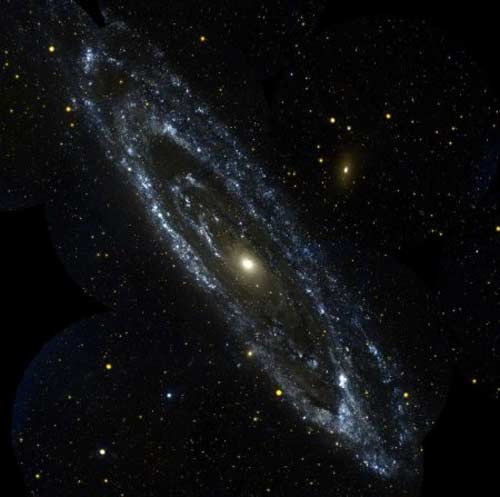Recent observations using the Keck Telescope have tripled the width of Andromeda’s main disk, from 70,000 to 220,000 light-years. This surprising new finding is challenging astronomers as they try to model how galaxies form.
Observers could not grasp the full size and extent of the Andromeda Galaxy (M31) until observational technology let them capture the spectra of thousands of faint stars scattered far outside the galaxy’s visible disk.
Scott Chapman, an astrophysicist at the California Institute of Technology in Pasadena, California, and his colleagues used the Keck’s DEIMOS multi-object spectrograph to record the spectra of 5,000 stars that were thought to be part of a spherical halo swirling around M31. The spectra revealed the stars’ chemical compositions, while shifts in color toward the blue or red ends of the spectrum showed how fast the stars were moving toward or away from Earth.
To the observers’ surprise, instead of the swarm of randomly distributed orbits expected within a galactic halo, they found nearly 3,000 stars circling M31 in a vast extension of its disk. The newly discovered region radiates about 10 percent of the galaxy’s light and contains millions of stars.
“This result is very new and exciting,” says astrophysicist Jeremy Bailin of Swinburne University in Hawthorn, Australia. “There have recently been discoveries of other interesting structures in the outskirts of M31, but this is the first evidence of a cohesive extended disk.”
“Most previous studies of the M31 ‘halo’ have actually been studies of this giant disk,” Chapman tells Astronomy. He presented the finding at the 206th meeting of the American Astronomical Society, in Minneapolis.
Chapman’s group traced Andromeda’s extended disk out to a diameter of 220,000 light-years, 3 times larger than the bright inner disk. “This resolves many of the old puzzles about what people thought was the halo,” Chapman says, “for instance, the fact that it appeared to have too many metals [heavier elements] to have formed in the very early universe.”
Astronomers believe metal-poor stars in typical galactic haloes formed earlier than stars closer to the center.
Once Chapman’s group clearly identified the extended disk, they used software to subtract it from their images of M31. That left a population of ancient, metal-poor stars that comprise a halo comparable to the one surrounding our galaxy. “We have been able to show that there is a metal-poor stellar halo underlying the giant disk, which is, in fact, very similar to the Milky Way,” says Chapman.
While the group’s findings greatly clarify the structure of M31, they pose a major puzzle concerning its history. The extended disk shows a “clumpy” structure, which theorists would expect if it formed by recent mergers with dwarf galaxies. However, it is hard to explain how such mergers could leave stars in such orderly orbits. “Mergers with small galaxies are expected to usually produce structure that’s more chaotic than a simple disk,” Bailin says.
“This remains a fundamental paradox to the study,” says Chapman.
He and Bailin hope more detailed observations and simulations of the disk eventually will solve the mystery. In the meantime, however, Chapman suspects that “the disks of spiral galaxies may not form in quite as straightforward a manner as models now suggest they do.”










